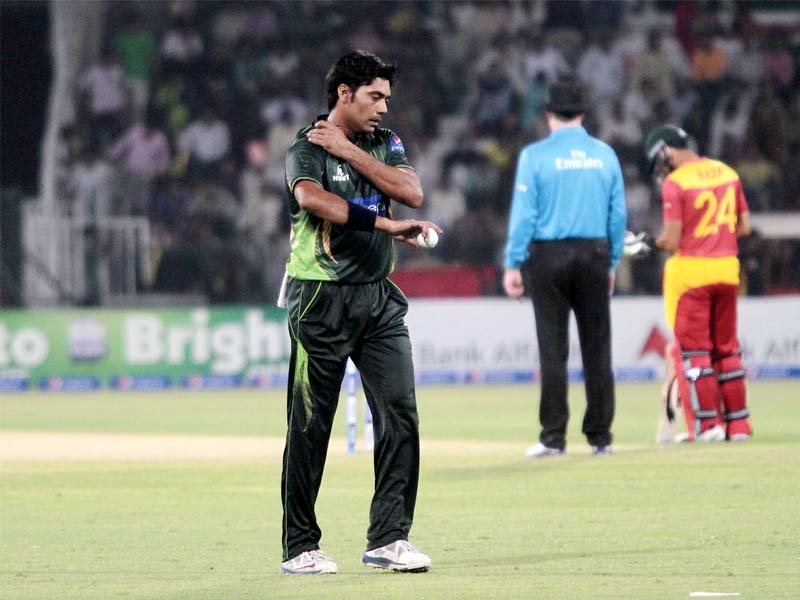
On a lively track, Sami generates extra pace and nip off the track and with a potent outswing, the right-armer wreaks havoc — at least in domestic games.
Some 15 years ago, a wiry Sami burst onto the international scene and immediately made the batsmen shiver with his thunderbolts. There was an overwhelming aura of complacent ease as one in-swinging yorker after another broke the defences of a beleaguered bunch of New Zealand batsmen in the Auckland Test of 2001.
In the next Test at Christchurch, Sami offered the first glimpse of a conundrum that was to besiege him for the remainder of his career. In 47 futile overs, he failed to control his length and direction, and infuriatingly, that very performance was to become a constant in the years ahead.
Fast-forward to 2015: from absolute obscurity, Sami got an international recall. Conservative estimates suggest that the present comeback is his 14th encounter with top-level cricket.
But there was more torture and misfortune in store for both Sami and his long list of die-hard supporters. Even after a lifetime of bowling experience, Sami’s waywardness remains his Achilles heel.
The 34-year-old looked as fit as ever, and perhaps the pace hasn’t gone down more than a notch, but the lack of control bordered on the diabolical.
Sami looked mean and menacing in the opening T20I against Zimbabwe, but found himself on the wrong end of the tide that was in full motion off Elton Chigumbura’s bat in the second match of the series. Three consecutive sixes smote off the Zimbabwean skipper’s bat; after every shot, Sami returned to his bowling mark with his head down.
The three-for in the opening T20I opened doors for his inclusion in the ODI series. In the first two ODIs, the new-ball spells were promising, but on both occasions, he buckled under the onslaught in the middle and death overs.
The man in his mid-thirties resembled a clueless teenager — head bowed and poker-faced, perhaps the loneliest man amongst 25,000 fans, the two squads and the team of officials.
Sami’s last three ODIs — spread over three years — present a harrowing tale.
In 2012, Angelo Mathews took 15 runs off his last over — the final over of the match — at Colombo to seal a dramatic ODI series win. Sami leaked 75 runs in 9.4 overs and remained wicket-less.
Then after a three-year break, the first ODI in Lahore saw Chigumbura give Sami a return of none for 63 in seven overs; 45 coming off in the last three overs of his spell.
Chigumbura was then banned for a slow over-rate indiscretion, but Sami’s fortunes hardly budged. After seven relatively decent overs, he gave away 25 runs in the last two overs of the second ODI — a match return of nine overs, none for 53.
The overall equation in these three ODIs reads none for 191 in only 25.4 overs; an economy rate of close to eight runs an over.
Unpredictability is the only predictable element of Pakistan cricket, but after the despondency in Lahore, not many would count on Sami’s return, at least in the ODI format.
A man of few words
Sami is not known to speak a lot. The Sami smile is a tale of pain and agony; perhaps the fakest of all. The self-consumed Karachiite generally abhors interaction with cricket buffs, even journalists. The Sami reply to a question is generally a single word — yes or no.
On the eve of the second T20 against Zimbabwe, the broadcaster interviewed Sami for some three minutes, and was rewarded with his one-liners that lasted three seconds at most.
Some prominent names in Pakistan cricket have worked closely with him. At the forefront is his department’s (PQA) sports head, Rashid Latif, who is clueless about Sami’s predicaments that boil down to the failure of replicating his domestic form in the international arena.
“I think he needs to see a shrink,” says a bemused Latif. “There has to be something that is beyond his control, I can’t tell you how frustrating it is to see him flounder, given the natural talent and ability he is blessed with.”
The ace gloveman and former Pakistan captain is not the only one who bemoans the Sami failure.
Another ex-captain Moin Khan, under whose captaincy Sami delivered the Auckland debut blitz, is equally dejected. “Sami is an exceptional talent, I haven’t seen a fast-bowler anywhere who can field the way Sami does and is as handy with the bat,” said Moin. “Sami’s inconsistency has been a serious let down; it pains me to see him fail.”
For now, there is no guarantee about the duration of his latest return. The fragility of Pakistan’s fast-bowler may just allow a few more games in Sri Lanka next month.
In ODI captain Azhar Ali’s words, Sami, despite his advancing years, was the fastest bowler in the country after a heady skirmish with the pacer during the Pentangular Cup earlier in the year. But one doesn’t know yet how Azhar rates Sami’s chances for the Sri Lanka tour after the Zimbabwe show.
The Sami story threatens to end on a tragic note; the heart weeps, yet hopes for a miracle.
Published in The Express Tribune, June 3rd, 2015.
Like Sports on Facebook, follow @ETribuneSports on Twitter to stay informed and join in the conversation.
1725354252-0/Untitled-design-(5)1725354252-0-405x300.webp)
1732099866-0/adele-(3)1732099866-0-165x106.webp)



1732086107-0/BeFunk_§_]__-(9)1732086107-0.jpg)











COMMENTS (6)
Comments are moderated and generally will be posted if they are on-topic and not abusive.
For more information, please see our Comments FAQ